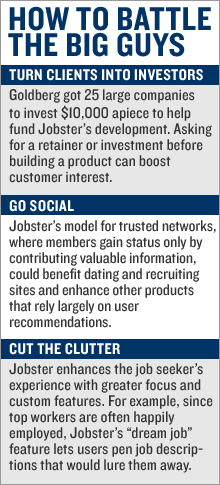CNN money
By embracing the latest Web technology and crafting its product to suit power users, scrappy Jobster is laying into the industry giants.(Business 2.0 Magazine) -- Eat a meal with Jobster CEO Jason Goldberg and you'll quickly notice his disdain for menus; the man already knows what he wants. Why waste time on an exhaustive list of options?
And it's not just a food thing. Years ago, as T-Mobile USA's strategic planning director, Goldberg grew frustrated with the flood of unqualified applicants he usually got from job boards. The laborious vetting process hardly seemed worthwhile, especially since the best prospects often came from employee referrals anyway.
 |
| TALENT SCOUT: Jobster CEO Jason Goldberg helped triple visits to the online job site while simplifying the recruiting process. |


So in 2004, Goldberg approached Ignition Partners, a venture firm in Bellevue, Wash., with a plan to reinvent online recruiting by combining the referring power of a social network with the focus of a recruiter's perspective. He called his creation Jobster.
Three years later Monster.com and the other online giants that once snatched the recruitment business from newspapers have reason to watch their own backs. Hiring managers, their most important customers, are weary of ordering off the menu - sifting through thousands of online resumes in search of the perfect applicant. Upstarts like Jobster are eager to turn that dissatisfaction into dollars.
And that's exactly what's happening.
When Jenny Leger was looking to hire new property managers for her real estate investment firm last year, her first stop was not Monster.com and its hordes of job seekers. Instead, Leger, recruiting director for Weidner Investment Services in Kirkland, Wash., pulled up Jobster's customizable site that applies the MySpace friend-network concept to the corporate talent search.
Within days Leger had made a hire, and in just a couple of months she had filled 11 positions. "The quality of applicants is exceptional," Leger says. That's partly because candidates tend to be recommended by trusted people in Weidner's Jobster referral network.
Weidner is just one of 475 corporate clients Jobster has signed since its launch in 2005. Others include Electronic Arts (Charts), Expedia (Charts), and 20 Fortune 100 companies. Meanwhile, Jobster's client roster is growing by 30 percent each quarter, and site traffic tripled last year. Goldberg says more than half of Jobster's $48 million in venture funding is still in the bank, and - thanks in part to a January restructuring in which the company laid off 60 of its 148 employees -he expects it to be profitable by year's end.
How is Jobster making inroads against its larger rivals?
To hear Goldberg tell it, he saw a shift in the online jobs landscape and created customizable Web 2.0 tools to address the market's needs. By persuading his target customers to help develop the product, tapping into the social-networking craze, and delivering a personalized experience to recruiters and job seekers, he's gaining a foothold in a crowded market.
"Web 1.0 was all about getting it online. Web 2.0 is about making it work," Goldberg says. "Posting the job is not the value. It's matching the right person to the job. That's the real business problem."
On the face of it, the Jobster idea seemed insane. The three big job boards have intimidating pedigrees: Monster.com (Charts) is synonymous with job search, Career-Builder is an alliance of powerful U.S. newspaper companies, and HotJobs is owned by content giant Yahoo (Charts). IDC estimates that the three of them accounted for about 75 percent of the $1.3 billion in revenue racked up by online job boards in 2006.
What makes Jobster different is its focus on using a referral network to save time for recruiting managers. Rather than try to provide the biggest resume database and the most job listings, Jobster offers a host of tools to nurture a pool of job candidates.
Recruiters begin building a network by sending a Jobster e-mail to employees, describing a job opening. Using the e-mail's "Send to Friends" button, employees can conveniently pass along the job description to their contacts. Each recipient can join the company's referral network with the click of a button, and the unique URL behind each button allows a manager to track leads through the customized Jobster dash-board. As the leads come in, recruiters can categorize them using criteria such as skill level and referring source.
"The key is, it's really, really easy," says Ted Moore, a recruiting manager at Automatic Data Processing, based in Roseland, N.J. Jobster's efficiency has helped ADP cut its job board budget by more than half. And ADP is now making more hires than ever through referrals. Since the company started using Jobster last January, some divisions are filling two-thirds of their open positions from employee referrals, up from half previously.
Goldberg has struck a nerve in the hiring community with his use of tailored social networks to drive results. In a Booz Allen Hamilton survey last year of 73 leading employers, 88 percent said the best job applicants come through referrals - yet fewer than one in five candidates was referred.
Like many recruiting professionals, TiVo (Charts) staffing director William Uranga wants change. "The mass approach of job boards is not what we're looking for," Uranga says. "What we're facing is, How do we build communities of people with whom we have relationships, before we have a job need?"
Uranga's new answer: Jobster.
